- Chapter 1Why Is Client Reporting Important?
- Chapter 2Creating a Framework for Client Success
- Chapter 3What Is a KPI?
- Chapter 4The Key Differences Between KPIs vs Metrics
- Chapter 5Top Digital Marketing Metrics to Showcase Success
- Chapter 6What To Include in Client Reports
- Why Client Reports Matter: Key Components of Client Reporting
- Using KPIs and Metrics as the Starting Point for a Great Client Report
- What To Include in a Comprehensive Client Report
- How One Firefly Uses AgencyAnalytics to Engage Their 600+ Clients Every Month
- Automated vs. Manual Reporting
- Chapter 7Using Data Storytelling in Client Reports
- Chapter 8How To Use Automated Client Reporting To Reclaim Billable Hours
- Chapter 9Advanced Client Reporting Strategies & Best Practices
- Chapter 10Buying vs. Building a Reporting Platform
A well-crafted client report isn't just a data dump; it's the linchpin that holds the agency-client relationship together. Striking the right balance in the information you present is critical. Do it well, and you set the stage for a partnership built on trust and open communication. Get it wrong, and you risk confusing or even alienating your clients.
Reports play a crucial role as they are a reflection of our agency's professionalism and expertise. If the reports sent to clients were not polished and visually appealing, it would undermine the credibility of the information within.
Alexa Rees, SEO Manager, seoplus+
Regardless of the client or their industry, a solid report is all about presenting relevant, timely data in a way that showcases the impact of your agency's efforts. These reports offer an invaluable opportunity for transparent communication, laying bare your triumphs and areas for improvement.
Survey data underscores this importance: 36% of agencies point to transparency and effective communication as the top factor in client retention, closely followed by campaign performance at 31%. In other words, a standout client report simultaneously addresses all these critical elements.
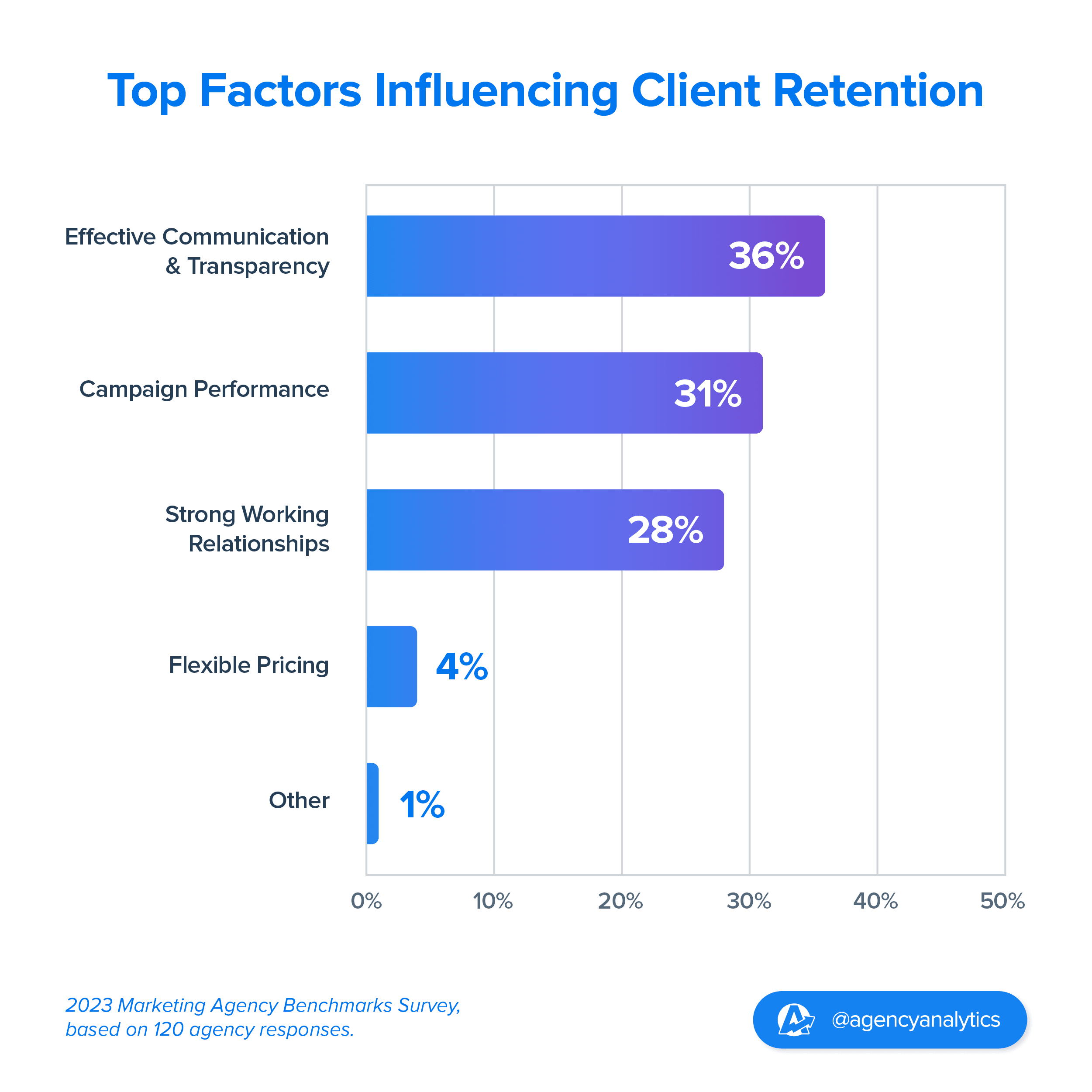
Whether you're detailing metrics from a comprehensive social media strategy or analyzing e-commerce KPIs, a good client report is your one-stop shop for all the essential information. Think of it as your playbook—a tool that reports past performance and guides future actions.
With AgencyAnalytics, we are able to centralize all the data in one place, enabling us to easily track and analyze campaign results across different channels.
Jessica Crist, Production Manager, High Five Media
Imagine you're in a client meeting, and the client is questioning why the PPC budget allocation is heavily skewed toward a specific ad group. Fortunately, you've come prepared with a robust client report that's visually engaging and data-driven.
You quickly navigate to the section that highlights the click-through rates (CTR) and conversions for each ad group. Next, you show a time-series chart illustrating how this ad group's conversions have spiked in the last quarter. You don't stop there. You then pull up relevant Google Ads metrics, like Cost per Acquisition (CPA), showing that this ad group has been generating more conversions and doing so at a lower cost.
By leveraging your client report as a communicative tool, you demonstrate the effectiveness and ROI of the agency's PPC strategy. The goal is to tell a compelling data story that not only relays the metrics but also clearly explains how these numbers translate to business growth for the client.
Why Client Reports Matter: Key Components of Client Reporting
Whether it's about tracking ongoing campaigns, measuring ROI, planning future strategies, or building stronger client relations, the significance of a well-crafted client report is manifold.
Prove the value that you are currently bringing to your client, and they will trust you with more budgets and business.
Barry Martin, President & Creative Director, The Idea Center
The primary goals for creating client reports can be broadly categorized into three main pillars. These pillars work in tandem to offer a 360-degree view of your digital marketing efforts, facilitating both retrospective analysis and proactive planning.
Tracking: Key Metrics for Success
A client report serves as a detailed record, capturing snapshots of various objectives and key performance indicators over time. It allows both parties to observe what actions have led to successes or failures. From clicks and conversions to audience engagement and SEO ranking, comprehensive tracking paints a picture of the ongoing initiatives.
Measurement, Analysis, and Optimization: Data-Driven Decisions
Beyond tracking, client reports are the gauges that measure the effectiveness of different strategies and point to areas where optimization will improve performance. Are the client’s social media ads bringing quality traffic? Is the new SEO strategy paying off in higher organic rankings? The report delivers data-driven answers to these critical questions.
Future Planning: Using Client Reports as a Roadmap
The insights gathered from tracking and measurement provide the blueprint for future strategies. A well-structured client report helps identify patterns and trends that serve as the foundation for the next phase of campaigns, offering valuable intelligence on what to continue, modify, or discard.
The Role of a Client Report in Relationship Management
Client reports also provide emotional intelligence in report form. They reveal the agency's skills in adapting to challenges and capitalizing on opportunities, and serve as a trust-building mechanism, assuring clients that their investments are managed with expertise, transparency, and attention to detail.

Every client is unique, with their own business objectives, audience demographics, and market conditions. A cookie-cutter approach to client reports will fall flat because it ignores this crucial variability. Report customization is not just a good practice; it's a necessity.
Customized client reports boost:
Relevance: When a report is tailored to a client's specific needs, every data point and insight becomes immediately relevant, making it easier for clients to apply these findings to their business strategy.
Engagement: A customized report is more engaging because it speaks the client's language (both literally and figuratively), focusing on the metrics and goals that matter to them, which–in turn–makes the report more actionable.
Value: Customization showcases the agency's commitment to delivering value, going beyond generic metrics to mine insights that offer a competitive edge to the client.
The essence of a client report transcends its pages and charts. It's a tool of connection, clarity, and customization that serves as a mirror reflecting past performance and a lens focusing on future opportunities and strategies.
The ability to customize every aspect of the reporting has allowed us to create an end result that gives our customers the answers they need.
Ryon Gross, CEO, Local Leap Marketing
Using KPIs and Metrics as the Starting Point for a Great Client Report
Your client probably doesn't care about every metric you could report on. They want a clear understanding of how your efforts align with their business objectives. That’s why building your client reports around specific KPIs is essential, rather than overwhelming them with a sea of data.
As we discussed in Chapter 3, by focusing on KPIs, you move beyond just presenting data points and start telling a story that resonates with your client's goals. For instance, if your client's primary aim is to increase brand awareness, metrics like impressions and reach take center stage. If the focus is on sales, then conversion rates and return on ad spend (ROAS) are the stars of the show.
With custom dashboards, we’ve successfully consolidated the data we want to see for every client, easily identifying potential issues with their campaigns. This centralized approach saves us valuable time and empowers us to proactively address and flag any concerns, fostering a proactive and efficient workflow.
Alexa Rees, SEO Manager, seoplus+
Tailoring your report to highlight these targeted metrics provides a unified narrative that ties directly into the client’s overall marketing strategy. Say goodbye to disparate metrics and offer a panoramic view of how each tactical element contributes to strategic goals.
Document Milestones With Goals and Context
A static list of numbers can't convey progress or setbacks. Top-tier client reports are dynamic, living documents that evolve with the project. Using goals and contextual annotations offers a quick visual snapshot of how close (or far) the project is from achieving the set KPIs.
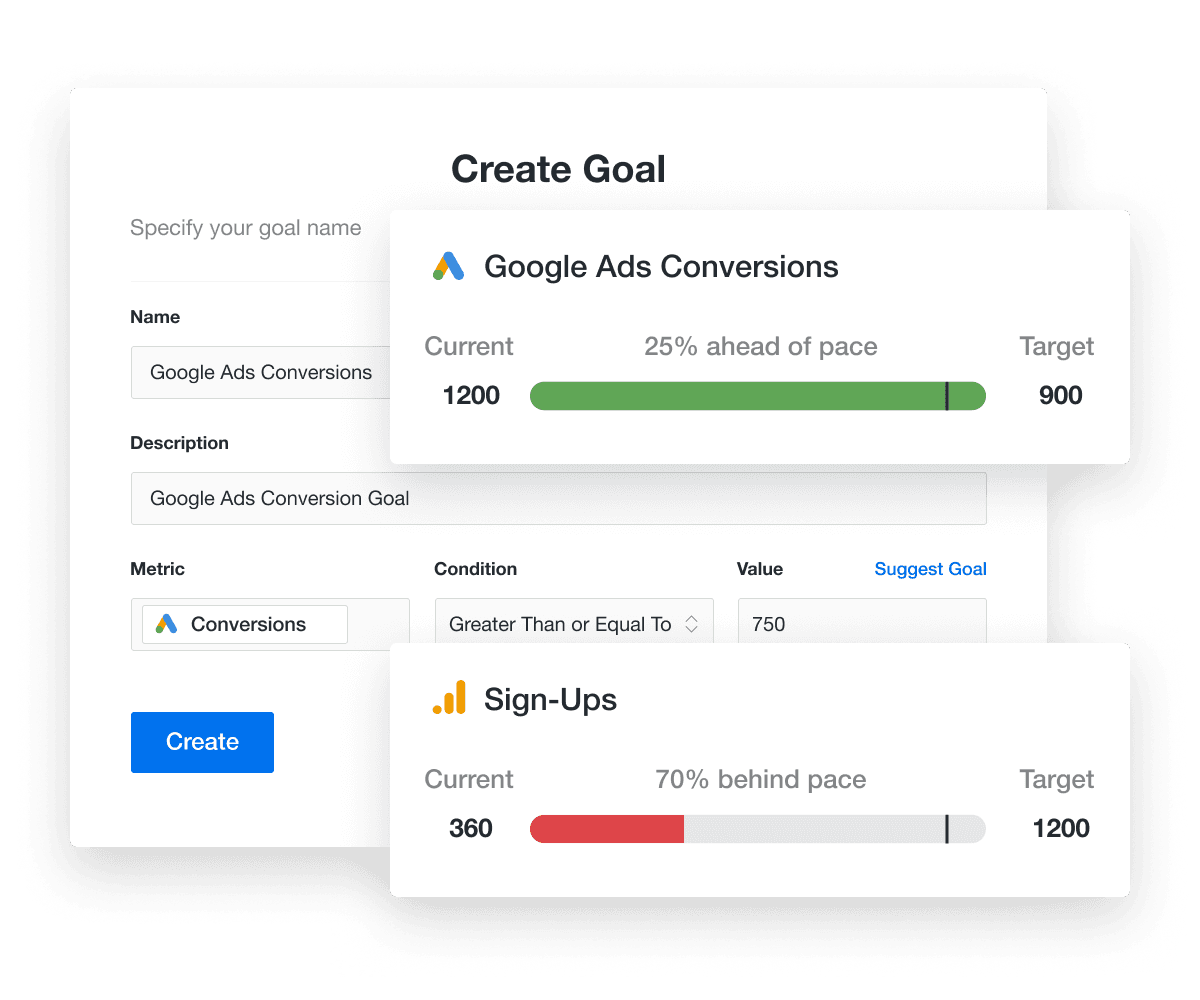
Annotations also provide insights into why certain metrics might have fluctuated, keeping the lines of communication open and flowing as the campaign progresses.
Be transparent with your clients that not all outputs/deliverables have a linear impact. Some are harder to measure because they play an important part somewhere in the customer journey, but just because they aren't part of the final conversion stage doesn't mean they aren't vital.
Andy Robson, Agency Founder, Squidgy
Provide a Window Into Progress With Real-Time Dashboards
In today’s instant gratification world, waiting for a monthly report isn't going to cut it for many clients. Real-time dashboards offer an immediate view of how a project is tracking toward its KPIs. This transparency doesn't just build trust; it encourages accountability among team members who will see how their contributions are affecting outcomes.
Having the ability to share access to the live dashboards with clients allows them to dive deeper into the analytics without needing us to dig up specific metrics on their behalf. This has reduced the number of requests/calls we receive from clients throughout the month.
Bryan Lozano, Vice President of Operations, Ad-Apt
And yes, if your client wants to check the dashboard three times a day, they can do that too—thanks to customized user permissions that allow you to control exactly what the client can see.

So, the next time you're crafting a client report, remember: The key isn’t to inundate the client with information but to curate the information that counts.
By doing so, you reinforce the value your agency brings to the table while also making it easier for the client to see why sticking with you is a smart business decision.
What To Include in a Comprehensive Client Report
To craft a client report that aligns your client's business objectives with your agency's efforts, you need to include real, actionable insights that provide clarity on performance and roadmaps for future strategy.
Let's get into the nitty-gritty of what makes a report not just good, but invaluable.
1. Designed Cover Page
The first impression of your client report needs to be a strong one. Start every client report with a custom-designed cover page that embodies your agency's professionalism.
Time savings is very important for me as CEO, less grunt work is important for my employees, and professional-looking reports are important for our branding and for our customers.
Nico de Jong, CEO, Forward Marketing
Change background colors or upload a custom image to reinforce your agency’s brand identity. Tweak titles and image widgets to further align with your unique style. These design customizations can be carried and adjusted throughout your report.

2. Report Summary
Your report summary is the elevator pitch of your client report. This isn't the place for vanity metrics or a cursory overview. Instead, focus on vital performance indicators, key accomplishments, and areas of concern.
Tell a story. Everyone loves a good story. Center the client as the hero by understanding how they can overcome the issues in their business with your service.
Tyler Hanson, Owner, Hite Digital (Chandler, AZ)
Remember, it's not just about what has been done but what needs to be done next. Make it short, insightful, and actionable.
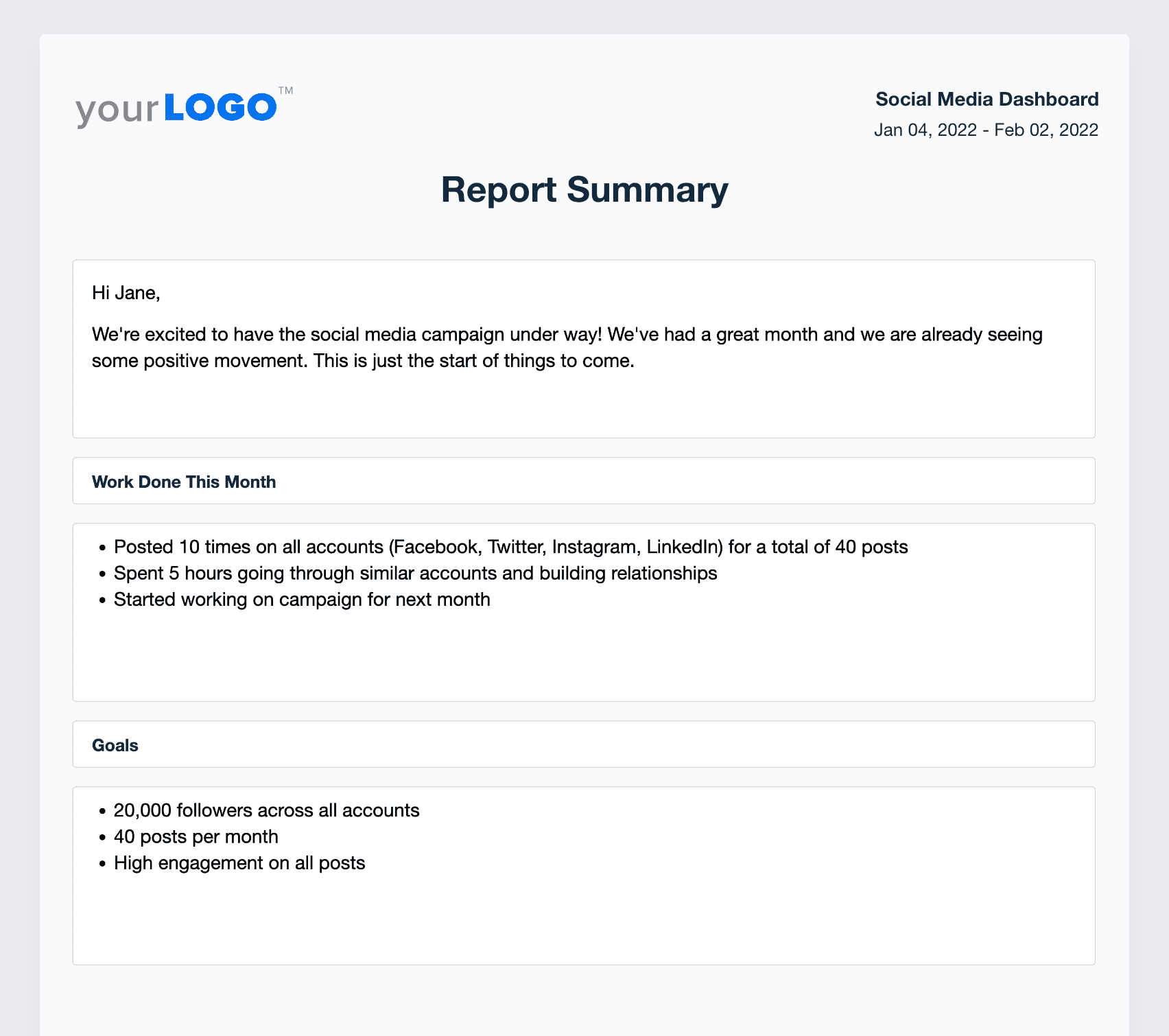
3. Website Analytics
Website traffic is often the pulse of any digital marketing strategy. But remember, all traffic isn't created equal. Use Google Analytics 4 to pinpoint how different channels drive website traffic and how that traffic supports the end results.
Our clients care most about rank. For us, that's only part of the story; we get them to also look at how rank translates to traffic and conversions. AgencyAnalytics is a big part of having conversations with our clients.
Scott Gingrich, CEO, GravityStack Marketing
Get specific about metrics like bounce rate, page views, and average session duration. More importantly, tie these metrics back to business goals—be it lead generation, sales, or brand awareness.

4. Performance by Channel and Platform
Each channel—from organic search to paid ads to social media—plays a unique role. And your client report should reflect that. Break down performance by each channel, highlight what's working and what isn't, and provide granular yet focused insights.
The most important metric depends on your goal. If you want to raise brand awareness, reach might be most important. If you want to drive website traffic, then link clicks would be most important. The best thing about the variety of metrics available is that you can use the platform to drive a whole range of business goals.
Ellen Hedley, Co-Founder, Vida Creative
For example, if SEO efforts are driving high-quality traffic, but social media is faltering in engagement, flag these for future attention.
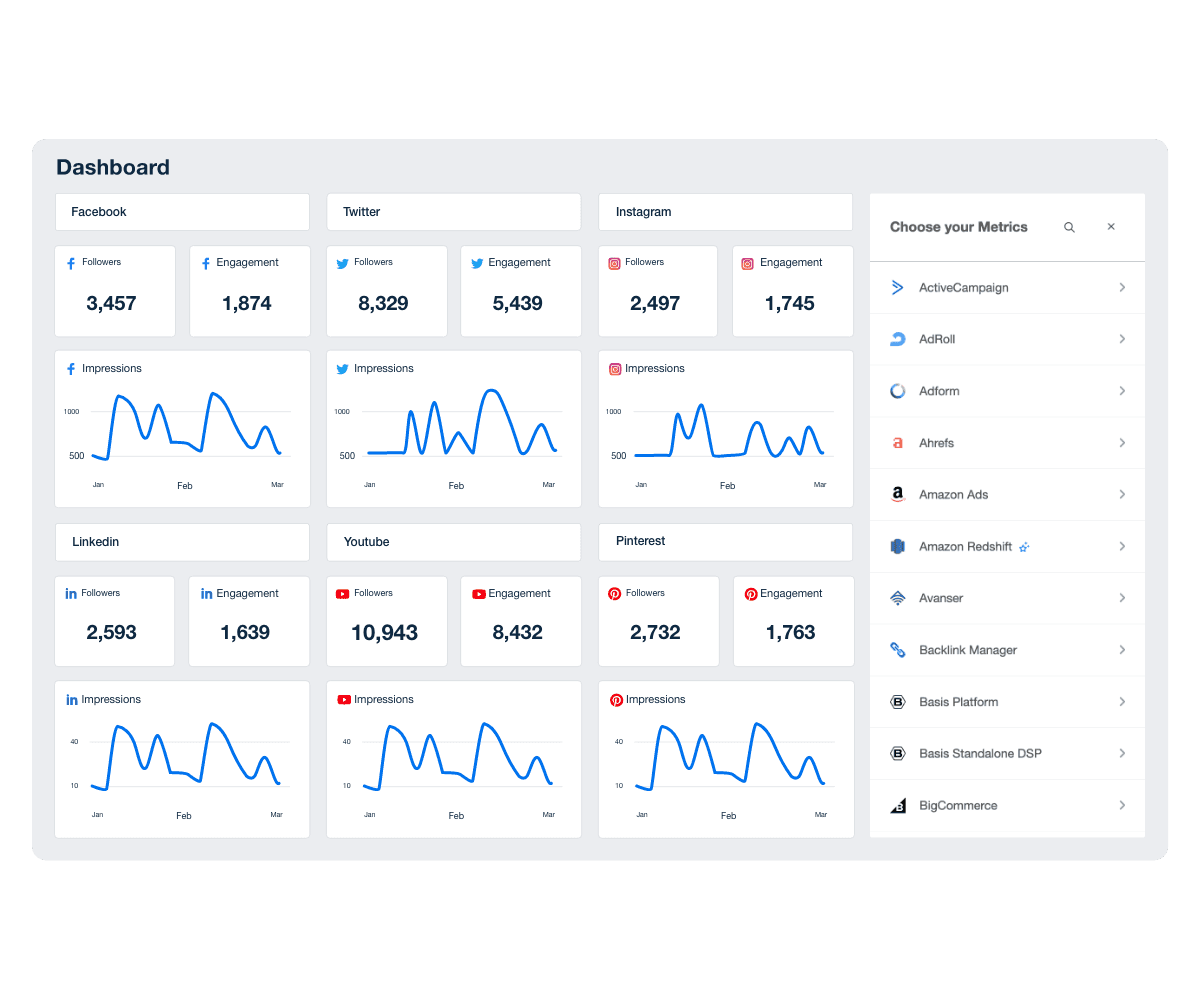
5. Budget and Goals Pacing
Let's talk about money. Not in a dramatic, reality-TV showdown way, but in a focused, ROI-centric manner. Compare budget spend to the results obtained.
As stewards of their marketing budgets, we prioritize communication, attentiveness, and results to maintain a healthy and productive partnership. Building trust through a consultative approach enhances the relationship and adds ongoing value that your clients will appreciate.
Jason Willis, Creative Director, Social Firm
Are the campaigns on track to meet the goals set out at the beginning? If yes, fantastic—what can be scaled? If not, why? Include recommendations for budget adjustments if needed and budget pacing strategies for the coming period.
6. Custom Metrics
While standard KPIs are well and good, each client will have specific needs requiring custom metrics. Maybe it's the earned media value of organic social media campaigns, or perhaps it's total spend across all of that client’s PPC campaigns.
Client dashboards and custom metrics are extremely valuable. We save a lot of time each month by sharing a dashboard where our clients can regularly check in and see status updates from our team. The ability to add custom metrics also makes things easier for us to aggregate KPIs across different channels.
Bryan Lozano, Vice President of Operations, Ad-Apt
The point is to dig deep into the data and pull out the metrics that speak directly to your client’s unique business objectives.
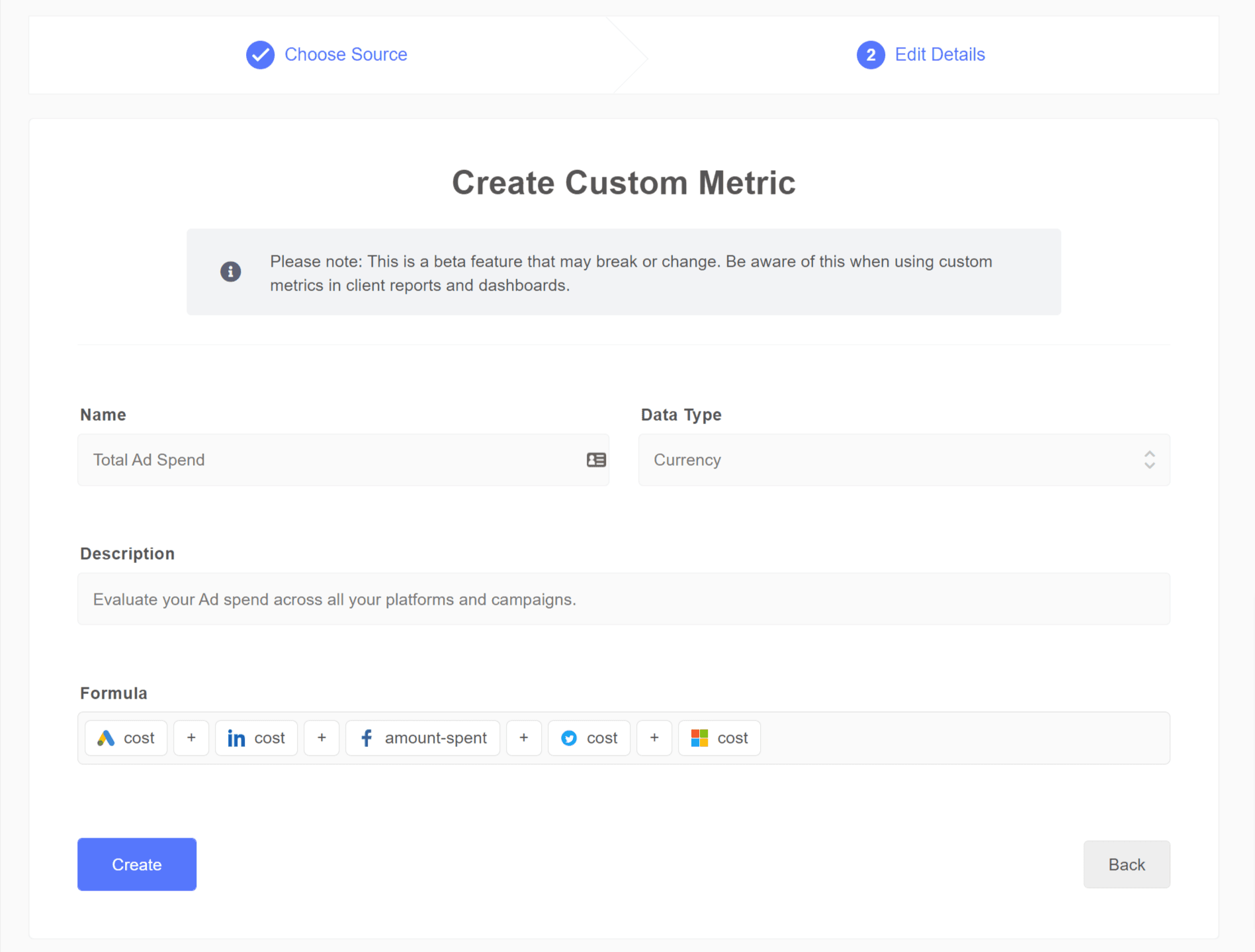
7. Data Visualizations
Data is the heart of your client report, but numbers alone can be a snooze fest. That’s where data visualizations come into play. Use crisp, clean charts and graphs to bring those numbers to life.
It's very difficult to explain the value of a service to a client without visuals. Using the web analytics report and the SEO reports side by side helps us show our clients a correlation between SEO and Traffic. We merge this data with a custom template that tracks conversions, and stripe data to show that traffic growth–from SEO and PPC–does have an impact on the number of conversions and revenue.
Ruben Roel, President, Investigator Marketing
Whether it's a bar graph showing month-over-month growth or a pie chart breaking down channel-specific traffic, visual aids make the data accessible and easier to digest.
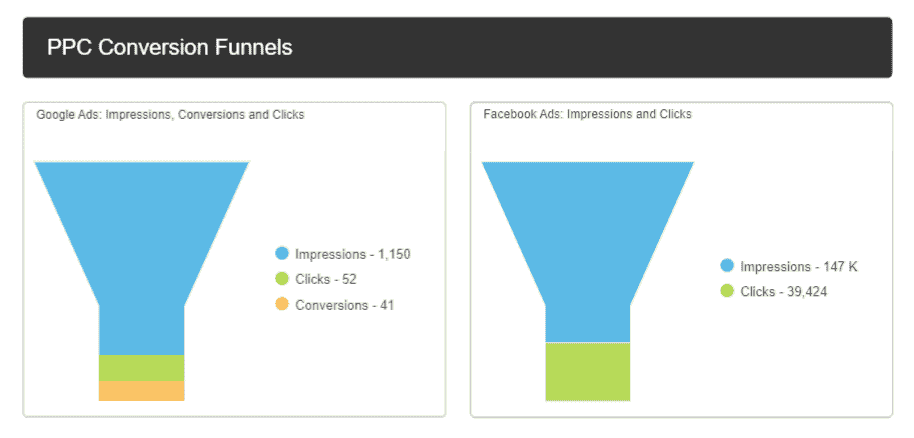
8. Context and Narrative
Data without context is like a compass without North—you're not quite sure which direction to go. This is where the narrative comes in. Each metric, each visualization, and each KPI needs a story that explains its relevance.
Data can be so in-depth and often needs context to evaluate how effective the campaign is, what needs to be adjusted, and how it impacts the long-term goal. Our clients get the best value when we interpret the data and provide recommendations.
Valerie Jennings, CEO, Jennings Social Media & MarTech
Why did organic traffic go up last month? What’s the real-world implication of a reduced bounce rate? Connect the dots between numbers and real business goals. Provide the “So what?” to the “What is this?”. It’s not just about data; it’s about telling the story of how this data is a stepping stone to future success or an alarm bell for imminent challenges.

9. White Label Branding
Last but not least, don't forget to wrap up your report in your agency’s branding. This adds a layer of professionalism and a hint of personal touch.
Consistent branding builds trust and positions our agency as a reliable partner in our clients' success. We present data in a clear and concise manner, making it easier for clients to understand their marketing performance and the value our agency brings to their business.
Jessica Crist, Production Manager, High Five Media
White labeling your client reports also keeps the spotlight on your agency's role in achieving the results laid out in the report. Keep it sleek, keep it branded, and most of all, keep it relevant.
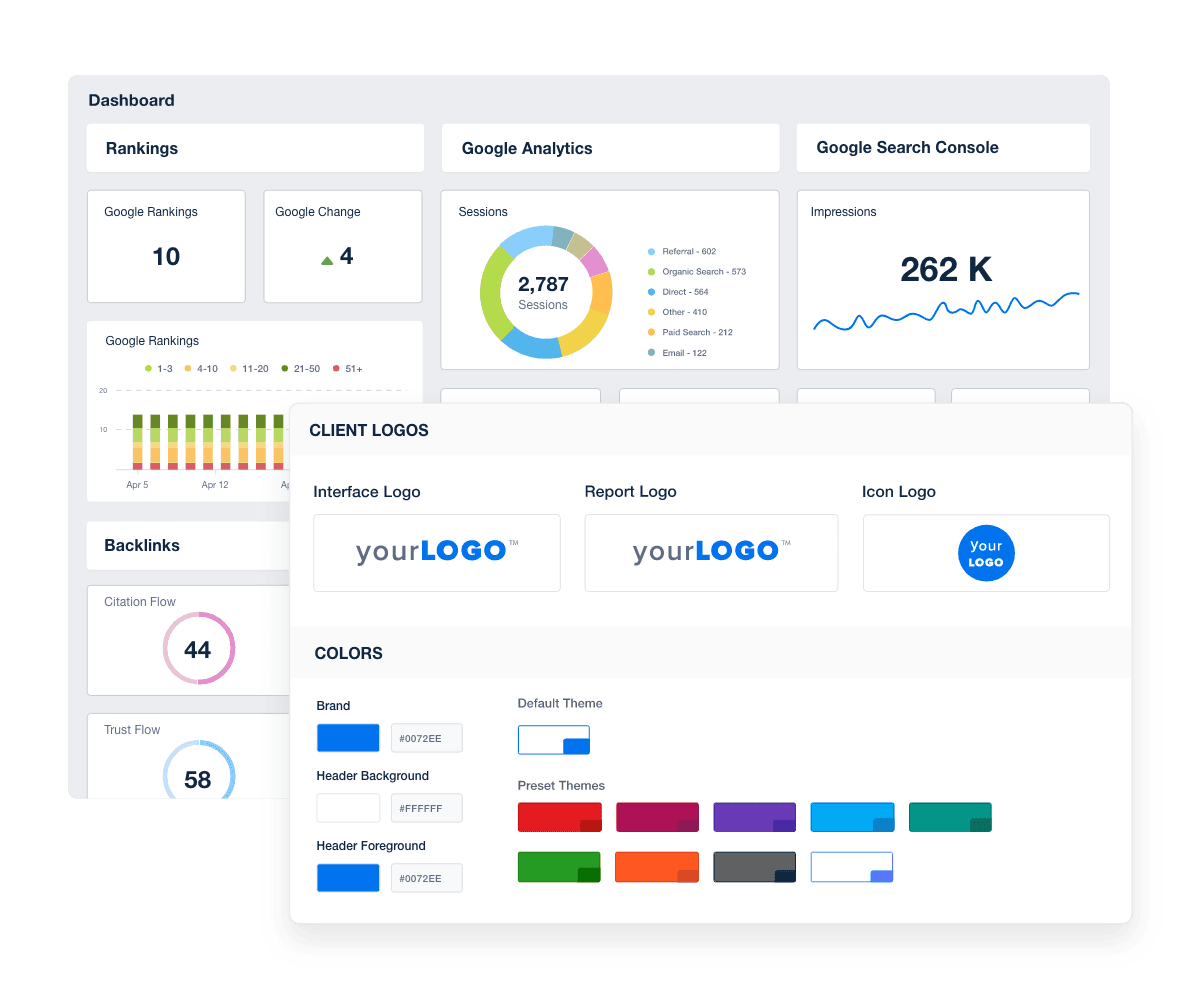
Use the cover and section design options to create a report that not only impresses with its data and metrics but also with its design.

Creating a client report is an art and a science that demands clarity, precision, and a dab of creativity. An engaging and easy-to-understand report isn't just a document you send and forget; it's the scoreboard in a continually evolving game. It helps foster meaningful conversations with your clients, keeps both parties accountable, and serves as the ultimate trust-builder.
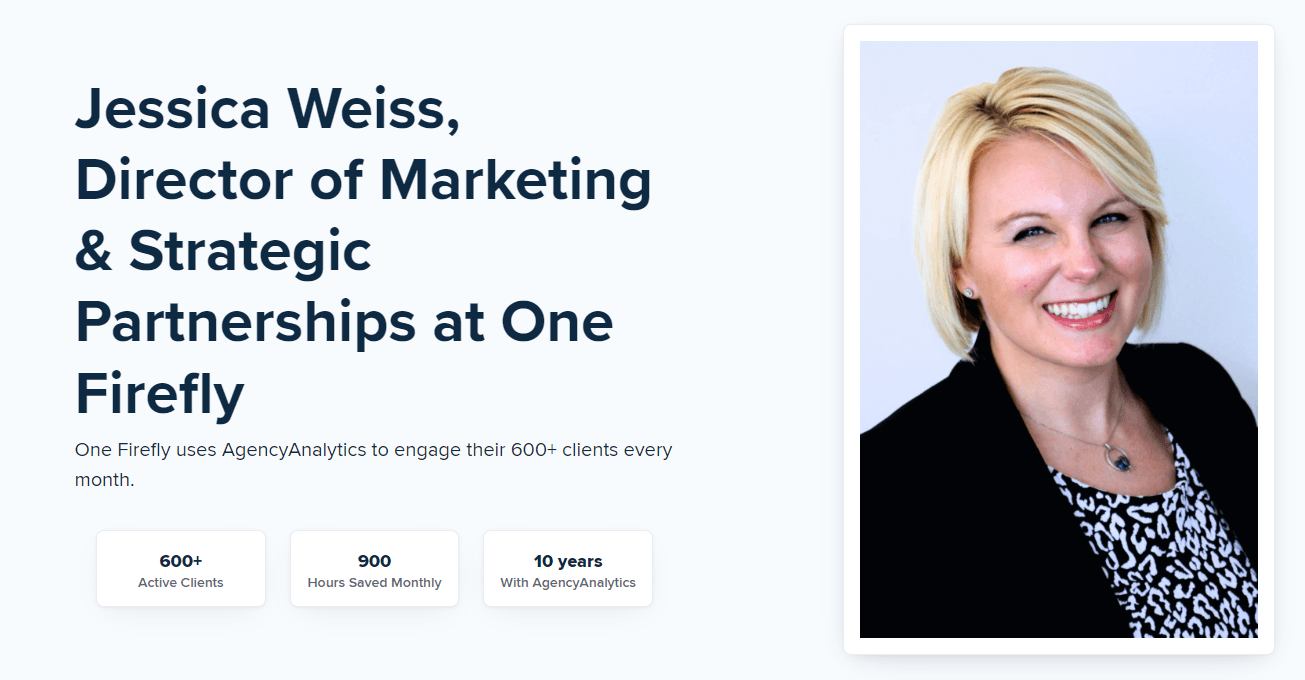
How One Firefly Uses AgencyAnalytics to Engage Their 600+ Clients Every Month
Meet One Firefly, a Florida-based digital marketing dynamo. Founded in 2007 with one employee, they’ve since grown to a team of 64. Originally, they cut their teeth working with custom integration firms, providing design and engineering solutions. But they soon expanded to include a host of marketing services for technology professionals, from branding and web development to PPC and SEO.
Problem: Reporting Challenges
Scaling is a good problem to have—until it isn’t. One Firefly discovered that as their client list expanded, so did their administrative headaches. Tailoring unique reports for each client became a tiresome endeavor. Add to that the task of identifying the metrics that mattered most to each client. As the adage goes, "time is money," and the team found themselves sinking into the quicksand of a cumbersome reporting process.
Solution: Overhauling Their Client Reporting Process
One Firefly chose AgencyAnalytics for its user-friendly design and automation features. By centralizing their client data, they streamlined their monthly reporting process. No more late-night number-crunching or hunting for relevant data points. The platform even gave them the flexibility to have face-to-face metric reviews with some clients while automating reports for others who preferred a hands-off approach.
Outcome: Improved Client Relationships and Agency Growth
With reporting made easy, One Firefly shifted gears back to what they do best—strategizing for client growth. The platform allowed them to effortlessly create custom or duplicate report templates. But it wasn't just about the numbers; it was about explaining the story behind them.
By offering clearer, more actionable insights, One Firefly elevated client conversations from data reporting to discussions of strategic direction. Clients and stakeholders appreciated this new efficiency, fortifying their relationships and fostering agency growth.
Lessons: Takeaways for Other Agencies
If you're wrestling with a clunky reporting process, take a cue from One Firefly:
Centralize Your Data: Having one go-to platform for all your client data turns chaos into harmony.
Automate Where You Can: Time saved on manual tasks frees you to strategize and grow the business.
Elevate the Conversation: Don’t just provide data; offer insights that steer client strategy and foster business growth.
Remember, reporting shouldn’t be a dreaded chore; with the right tools, it can actually be, dare we say, enjoyable!
Automated vs. Manual Reporting
Both automated and manual reporting have their merits and drawbacks, with the scale tipping based on various factors like agency size, client needs, and the complexity of campaigns. Let’s take a closer look at the nuances to help you determine which path is right for your agency.
Why Small or Early-Stage Agencies Often Rely on Manual Reporting
When you're just starting, the goal is to prove yourself. Each client is precious, and personalized attention becomes the cornerstone of your business ethos. Although not the easiest path, it often leads agencies down the road of creating reports manually.
Our old client reporting process was a headache, to say the least. We would spend hours gathering data from various sources, such as Google Analytics, social media platforms, and PPC campaigns. Then, we had to manually compile the information using screenshots, spreadsheets, and charts. The process was manual, error-prone, and not at all scalable. And don't even get us started on the stress levels at reporting time.
Adam Binder, Founder + CEO, Creative Click Media
However, with a limited client base and a constrained budget, the hands-on approach of manual reporting–often relying on spreadsheets or PowerPoint documents–offers the following advantages:
Customization: Every report can be tailored to the individual client's specific needs and questions.
Personal Touch: Manual reporting allows for in-depth insights and recommendations that are directly relevant to real-time events or shifts in strategy, adding a layer of context that automated reports might miss.
Cost-Efficiency: Manual reporting doesn't require an initial investment in automated software for agencies with more time than money.
Quality Control: With a smaller client roster, agencies have the time to meticulously copy, paste, and review data for each report to ensure accuracy and relevance.
However, it's not all sunshine and roses. Manual reporting is time-consuming and becomes increasingly unsustainable as the agency grows. The scope for human error is also higher, and there's a limit to how much data can be manually analyzed, affecting the depth of insights.
We initially did all of our reporting 100% manually. Spreadsheets & Google Docs with manually-entered data. It was insanely inefficient. Over time, we realized a need to be able to merge several different reporting elements and needed something more robust to take care of that.
Garrett Kite, President, Kite Media
Benefits of Automated Client Reporting
Switching to automated reporting feels like going from a bicycle to a sports car—faster, more efficient, and, let's admit it, flashier.
You wouldn’t think the little things make that big of an impact, but AgencyAnalytics has fundamentally changed our internal process for the better.
Michael Gasser, Co-Owner & Partner, Squeeze Marketing
Here's why automated reporting often becomes the go-to as agencies expand:
Time-Saving: Automation cuts down the hours spent on generating reports, freeing up time for analysis, strategy development, and client engagement.
Consistency: Automated reports ensure a uniform format and presentation, creating a cohesive brand image.
Scalability: As your client base grows, automated systems easily adapt, capable of generating multiple reports automatically or with the click of a button.
In-Depth Analysis: With time saved on report generation, agencies delve into more nuanced analytics, creating a richer narrative around the data.
Real-Time Access: Many automated platforms offer dashboards with real-time (or near real-time) data, making it easier for clients to stay in the loop without waiting for monthly or quarterly reports.
Error Minimization: Automated reporting reduces the human error factor, increasing the reliability of the data presented.
So, which method wins? Well, it's less of a contest and more of a relay race. Early-stage agencies often start with manual reporting but aim to pass the baton to automated systems as they scale.
The ideal reporting process often includes a mix of both, capitalizing on the strengths of automated reporting platforms but taking the time to infuse the personal touches and expert insights clients expect from your agency.
The only regret we have about switching to Agency Analytics is not doing it sooner. It has saved us an incredible amount of time and makes us look polished and professional. We love how it lays out the report, making it easy to read and present to the client.
Kim Walker, Co-Owner, Shop Marketing Pros
See how 7,000+ marketing agencies help clients win
Free 14-day trial. No credit card required.

